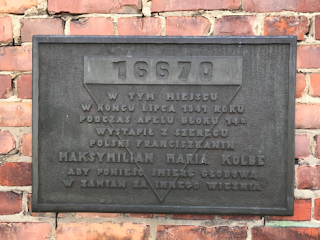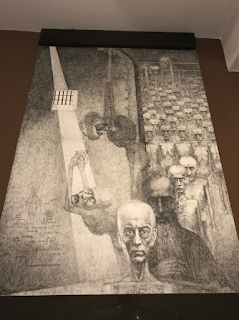Father Maximilian Kolbe is a Polish Franciscan Priest that died in Block 11 of Auschwitz I and a major reason why I decided to come to Poland to was to learn more about the Holocaust. My experience in high school was instrumental in forming my faith. Through retreats, theology classes and mission work, the Franciscan Brothers captured my heart and rooted it in service and solidarity. Kolbe was a major influence to me during this time. He was the perfect representation of the Franciscan motto, that I hold very dear, of preaching the Gospel at all times, and, only when necessary, using words. The retreat planned for the sophomore class of St. Anthony’s was focused on understanding the “other” and instilling an understanding that everyone has an “invisible backpack” that they carry their burden in with them. The life and mission of St. Maximilian Kolbe was used to illustrate this theme. My sophomore retreat impacted me deeply and inspired me to later become involved in coordinating and running the Kolbe retreat.
Coming to Auschwitz I and viewing where Kolbe was starved and eventually killed with injection after serving as a pillar of strength for other starving men in his cell, as well as other prisoners inspired by his selflessness in the camp, was a disorienting experience. Here, his story is among a million. A million other stories of suffering, loss, and persecution.
His story is honored because he was the only prisoner to have switched places with another in Auschwitz I. In the camp, the German Nazis minimized escapes by enforcing a policy of collective responsibility. If one man escaped, 10 others from his kommando or block would be chosen to be tortured and killed. One day, a man escaped therefore, 10 men from Kolbe’s block were to be chosen and killed. The SS lined the men up in the yard and picked 10 men. Suddenly, a man named Franciszek Gajowinczek started crying, pleading for his wife and children. Kolbe stepped forward and spoke directly to the guard, which broke every rule and could have gotten him shot on the spot. He asked the guard to switch places with the man, to which the SS guard agreed. Kolbe was taken to Block 11 with the 9 other men chosen to die in cell 18, the starvation cell. He survived in the cell for two weeks and then was injected with phenol by SS officers.
 |
|
A plaque with St.
Maximilian Kolbe’s prison number (16670) on it memorizing the spot in the camp
where he sacrificed his life.
|
Another prisoner in the camp was taken by Kolbe’s act of love and mercy. Mariana Kolodeijia was a prisoner on the first transport to Auschwitz. He was a Polish resister who survived five years in the camp. For almost 50 years, he found it impossible to speak about his experience, until having a stroke. When recovering, he started drawing, creating his testimony. Kolodeijia’s work is unique and extremely impactful. He depicted the horror and destruction in a way that empty buildings cannot. St. Kolbe was also a major influence in his experience in the camp which is seen through his art. Kolodeijia was a Catholic man, therefore Kolbe and Jesus Christ are two frequently repeated figures throughout the exhibition.
 |
|
Kolodeijia’s
artwork from the exhibit. There were multiple drawings of these eyes all
throughout the exhibition.
|
The drawings I was most struck by were the depictions of Kolbe and Christ throughout the exhibit. Several times, Kolodeijia shows Jesus being crucified with a crown of barbed wire, in a cell or on a post of the gate that surrounded the camp. In some, Kolodeijia and Kolbe are being drawn up by the barbed wire along with Jesus. Kolodeijia clearly sees Jesus suffering and dying with the prisoners of Auschwitz. In the course selection book, Jan Audrzej Kloczowski debated in an article where God was during the Holocaust and starts by asking if God can suffer. This is a large theological question that to fully answer, several angles must be considered, which are laid out in the article. However, when viewing Kolodeijia’s work is it hard not to see how God was with these people and suffered alongside them. He felt their pain and cried with them.
 |
|
Another piece of Kolodeijia’s art. In this image, Fr. Maximilian Kolbe is providing
support to those starving in cell 18 while the crucified Christ is watching
over them.
|
I am a big believer in seeing God in other people, and I believe Kolodeijia also lived with that notion. He saw God in Fr. Kolbe, as a Christ like figure who sacrificed himself for the welfare of another. There was a specific piece of art in the exhibit that impacted me. It depicted Fr. Kolbe, skeleton thin, number tattooed on this back, tied to a bar with barbed wire. In this image he is also wearing a crown of thorns. This image paralleling Christ’s crucifixion exemplifies the idea of God suffering through the suffering of his creation.
 |
|
Kolodeijia
portrays Fr. Maximilian Kolbe with a crown of thorns made of barbed wire.
|
At the museum, the Franciscan Priest gave us a photo pamphlet with some Kolodeijia’s work and a part of a letter he wrote. At the end of the pamphlet, there is a quote from Prof. Jozef Tischner which states, “the question, ‘where is God?’, hangs over the designs… but God can’t be where He wasn’t invited. Here lies man’s greatness: his ability to not invite God into his world and to even expel Him from it. And this is the world where God is driven out, expelled, and yet on the other land, at the same time, is present through Fr. Kolbe”. In Auschwitz and other camps, the Nazis expelled God, banishing Him from a place of such brutality. However, through Kolodeijia’s art, we can tell that they were unsuccessful. Through people in the camp, such as Kolbe, God remained present and suffered alongside victims. There are many accounts of Jewish prisoners keeping their faith alive, resisting spiritually against their victimization. They also invited God into Hell on earth. Their act of remaining faithful to God and not losing hope in Him is one of the most amazing acts of rebellion in the camp. Kolodeijia pays tribute to Jewish people who were targeted and murdered in Auschwitz. Kolodeijia was Catholic, therefore much of his work portrays Christ suffering, however the presence of God is with to all those in the camp through his work. He portrays God through his own tradition through most of his work and uses symbols of Jewish ritual and spirituality when memorizing them. All people of faith brought God into the camp through their spiritual resistance, fighting against the Nazi attempt to expel God through their evil actions against God’s creation.
 |
|
God was
there, crucified, strung up with barbed wire on a gate post, suffering with his
people.
|












0 comments:
Post a Comment